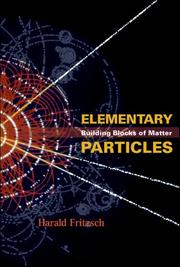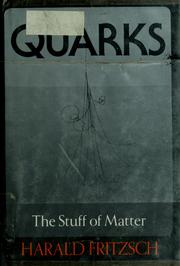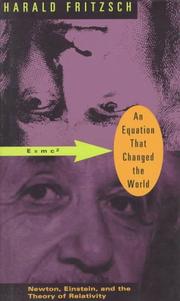| Listing 1 - 10 of 20 | << page >> |
Sort by
|

ISBN: 981256408X 9812561412 Year: 2005 Publisher: Hackensack, NJ : World Scientific,
Abstract | Keywords | Export | Availability | Bookmark
 Loading...
Loading...Choose an application
- Reference Manager
- EndNote
- RefWorks (Direct export to RefWorks)
This highly readable book uncovers the mysteries of the physics ofelementary particles for a broad audience. From the familiar notionsof atoms and molecules to the complex ideas of the grand unificationof all the basic forces, this book allows the interested lay public toappreciate the fascinating building blocks of matter that make up ouruniverse.
Particles (Nuclear physics) --- Quantum chromodynamics --- Quantum electrodynamics

ISBN: 0465067816 Year: 1983 Publisher: New York : Basic Books,
Abstract | Keywords | Export | Availability | Bookmark
 Loading...
Loading...Choose an application
- Reference Manager
- EndNote
- RefWorks (Direct export to RefWorks)
Quarks. --- Quarks --- 539.12 --- Elementary and simple particles (charge less than 3 including alpha-rays, beta-rays, gamma-rays as individual particles or as radiation) --- 539.12 Elementary and simple particles (charge less than 3 including alpha-rays, beta-rays, gamma-rays as individual particles or as radiation) --- Particles (Nuclear physics) --- Partons --- Quark-gluon interactions
Book
ISBN: 3319921940 3319921959 Year: 2018 Publisher: Cham : Springer International Publishing : Imprint: Birkhäuser,
Abstract | Keywords | Export | Availability | Bookmark
 Loading...
Loading...Choose an application
- Reference Manager
- EndNote
- RefWorks (Direct export to RefWorks)
Murray Gell-Mann, Physics Nobel Prize Laureate in 1969 is known for his theoretical work on elementary particle physics and the introduction of quarks and together with H. Fritzsch the “Quantum Chromodynamics”. Based on four sections the Editor gives an overview on the work of Gell-Mann and his contributions to various aspects of the physics, related to quarks. His most important and influential papers were selected and reprinted so that the reader easily can check the original work of Gell-Mann.
Quarks. --- Particles (Nuclear physics) --- Partons --- Quark-gluon interactions --- Particle and Nuclear Physics. --- Mathematical Physics. --- Nuclear physics. --- Mathematical physics. --- Physical mathematics --- Physics --- Atomic nuclei --- Atoms, Nuclei of --- Nucleus of the atom --- Mathematics

ISBN: 1281881031 9786611881030 9812569367 9789812569363 9789812561411 9812561412 9789812564085 981256408X 9781281881038 6611881034 Year: 2005 Publisher: Hackensack, NJ
Abstract | Keywords | Export | Availability | Bookmark
 Loading...
Loading...Choose an application
- Reference Manager
- EndNote
- RefWorks (Direct export to RefWorks)
This highly readable book uncovers the mysteries of the physics ofelementary particles for a broad audience. From the familiar notionsof atoms and molecules to the complex ideas of the grand unificationof all the basic forces, this book allows the interested lay public toappreciate the fascinating building blocks of matter that make up ouruniverse.
Particles (Nuclear physics) --- Quantum chromodynamics --- Quantum electrodynamics --- Electrodynamics, Quantum --- QED (Physics) --- Quantum field theory --- Schwinger action principle --- Chromodynamics, Quantum --- QCD (Nuclear physics) --- Elementary particles (Physics) --- High energy physics --- Nuclear particles --- Nucleons --- Nuclear physics
Book
ISBN: 3492006329 Year: 1984 Publisher: München Piper
Abstract | Keywords | Export | Availability | Bookmark
 Loading...
Loading...Choose an application
- Reference Manager
- EndNote
- RefWorks (Direct export to RefWorks)
Digital
ISBN: 9783319921952 Year: 2018 Publisher: Cham Springer International Publishing, Imprint: Birkhäuser
Abstract | Keywords | Export | Availability | Bookmark
 Loading...
Loading...Choose an application
- Reference Manager
- EndNote
- RefWorks (Direct export to RefWorks)
Murray Gell-Mann, Physics Nobel Prize Laureate in 1969 is known for his theoretical work on elementary particle physics and the introduction of quarks and together with H. Fritzsch the “Quantum Chromodynamics”. Based on four sections the Editor gives an overview on the work of Gell-Mann and his contributions to various aspects of the physics, related to quarks. His most important and influential papers were selected and reprinted so that the reader easily can check the original work of Gell-Mann.
Mathematical physics --- Experimental nuclear and elementary particle physics --- Nuclear physics --- wiskunde --- fysica --- atoomfysica
Book
ISBN: 1282441388 9786612441387 9812818200 Year: 2009 Publisher: Hackensack, NJ : World Scientific,
Abstract | Keywords | Export | Availability | Bookmark
 Loading...
Loading...Choose an application
- Reference Manager
- EndNote
- RefWorks (Direct export to RefWorks)
The speed of light, the fine structure constant, and Newton's constant of gravity - these are just three among the many physical constants that define our picture of the world. Where do they come from? Are they constant in time and across space? In this book, physicist and author Harald Fritzsch invites the reader to explore the mystery of the fundamental constants of physics in the company of Isaac Newton, Albert Einstein, and a modern-day physicist. The conversation that the three scientists are imagined to have provides an entertaining introduction to the constants and covers topics ranging
Book
ISBN: 0140158634 9780140158632 Year: 1992 Publisher: London Penguin Books
Abstract | Keywords | Export | Availability | Bookmark
 Loading...
Loading...Choose an application
- Reference Manager
- EndNote
- RefWorks (Direct export to RefWorks)
Book
Year: 1971 Publisher: München [s.n.]
Abstract | Keywords | Export | Availability | Bookmark
 Loading...
Loading...Choose an application
- Reference Manager
- EndNote
- RefWorks (Direct export to RefWorks)

ISBN: 0226265579 Year: 1994 Publisher: Chicago (Ill.) : University of Chicago press,
Abstract | Keywords | Export | Availability | Bookmark
 Loading...
Loading...Choose an application
- Reference Manager
- EndNote
- RefWorks (Direct export to RefWorks)
Physicists --- Relativity (Physics) --- Interviews. --- Popular works. --- Popular works --- Interviews --- Relativity (Physics) - Popular works.
| Listing 1 - 10 of 20 | << page >> |
Sort by
|

 Search
Search Feedback
Feedback About UniCat
About UniCat  Help
Help News
News